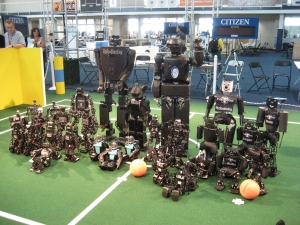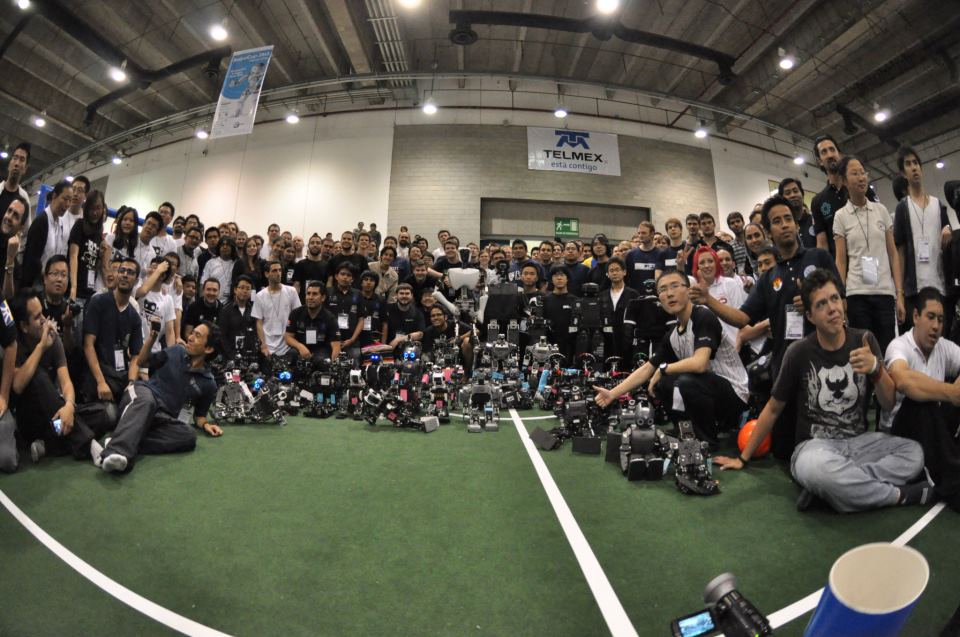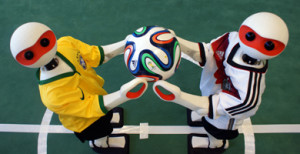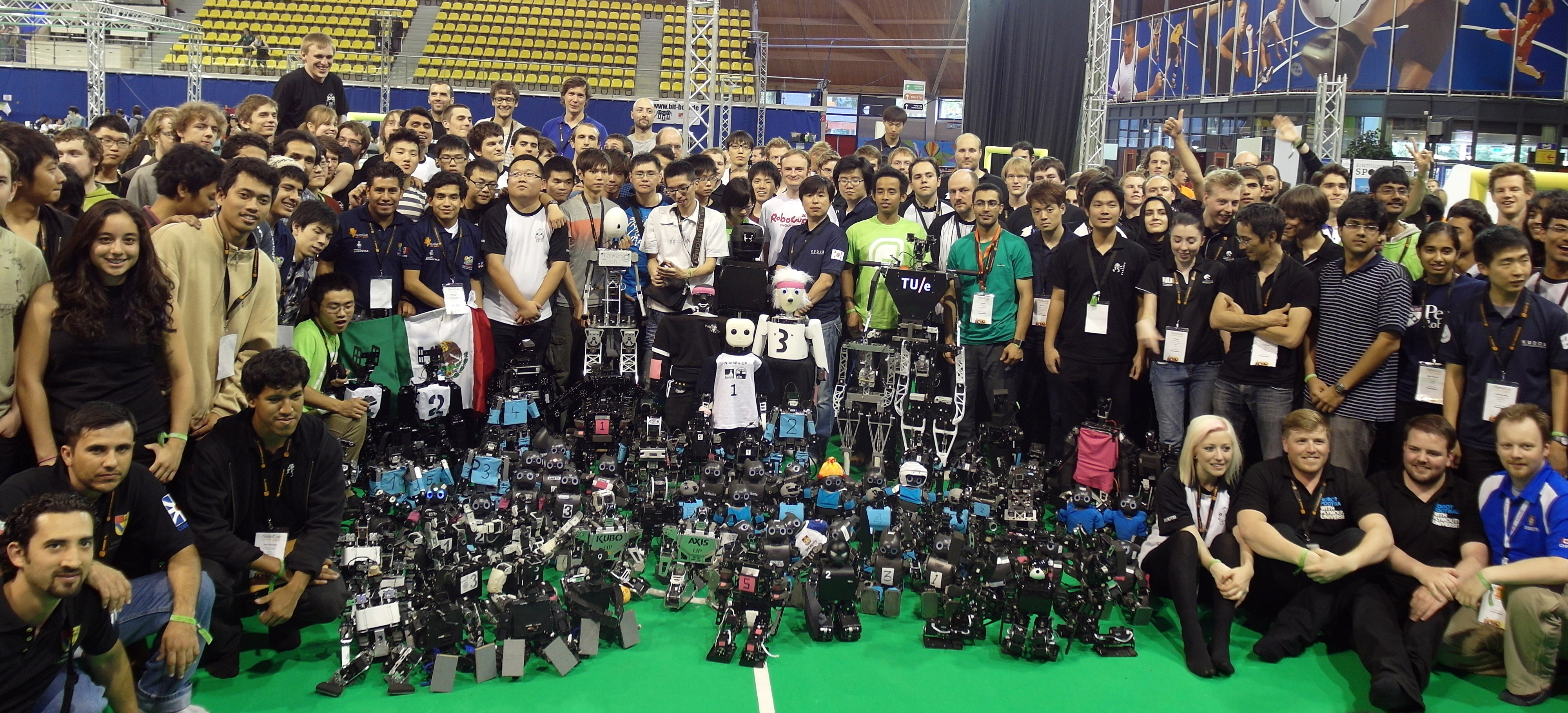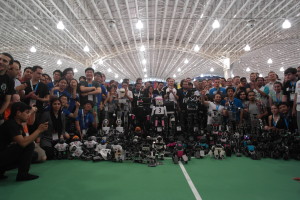The Early Years (2002-2004)
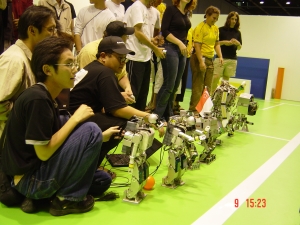 The Humanoid League is one of the youngest soccer playing leagues in the RoboCup competition. The first competition was carried out at RoboCup 2002 in Fukuoka, Japan. Building a fully autonomous humanoid robot that is able to play soccer games is still a challenging problem today, but it was clearly a blue sky-extremely ambitious with a high chance of failure-project in 2002.
The Humanoid League is one of the youngest soccer playing leagues in the RoboCup competition. The first competition was carried out at RoboCup 2002 in Fukuoka, Japan. Building a fully autonomous humanoid robot that is able to play soccer games is still a challenging problem today, but it was clearly a blue sky-extremely ambitious with a high chance of failure-project in 2002.
At that time, some impressive humanoid robots developed by the Japanese industry like Honda Asimo and Sony Qrio existed. However, these robots were not available to the Humanoid League teams, but only showed demonstrations in controlled environments. Even if they would have been available for purchase, their price tag would have been prohibitive. In 2003, a representative from Sony introduced the Sony Qrio- the successor to the widely successful Sony Aibo robot. In spite of the very ambitious goal, a hodge-podge of about a dozen teams entered the inaugural RoboCup Humanoid League competition in 2002 in Fukuoka, Japan. The robot designs varied from 20 cm to 180 cm tall robots. There were also many other differences between the robot designs. Another platform that was commercially available during that time was the Fujitsu HOAP series of robots. Their cost was about $150,000 USD, but they were not able to act fully autonomously because they did not have sufficient processing power available on-board. So all vision processing etc. had to be done on-board on a PC. Another difference was that several other teams were unable to move autonomously under battery power and had to be powered externally. Some teams were even completely unable to act autonomously and used remote control to move the robot towards the ball. Due to these constraints, the first RoboCup Humanoid League competition consisted of three events: balancing on one leg, free style demonstration (a panel of judges graded a short free style demonstration by the team), and penalty kicks. To allow these robots with very different capabilities to compete in the same event, the RoboCup Humanoid League Technical Committee (TC) introduced performance factors in order to level the playing field. For example, the performance factor for remote controlled operation was 100%, so a goal scored with remote controlled robot counted 50% of a goal scored by a fully autonomous robot. Since the Humanoid League TC realized that building your own robot was a significant challenge at that time and since it wanted to encourage teams to explore design ideas and build their own robots, commercial platforms were also penalized by a 20% performance factor. The RoboCup Humanoid League TC was acutely aware of the fact that building larger humanoid robots was even harder than building smaller humanoid robots, but that to achieve the goal of 2050 large humanoid robots are of strategical importance. Therefore, the RoboCup Humanoid League TC separated the league into three size classes: Small (<60 cm), medium (60 cm to 80 cm) and large (>80cm) robots.
The constraints of these early years influenced rule development in successive years and still influence the culture of the Humanoid League. The performance of the Humanoid League robots developed quickly. By 2004, all robots acted fully autonomously and all processing was handled on-board. Therefore, the need for the performance factors vanished and they were removed from the rule book. The rules evolved to provide fair and entertaining competitions that could still act as benchmark problems for our research into developing capable fully autonomous soccer robots. The main tournament was now played as penalty shootout. Standing on one leg was replaced by a Humanoid Walk competition, where robots had to footrace around a pole. Each year, a new technical challenge was introduced, in order to encourage development of new skills that were not yet applicable in the main tournament. In 2004, the technical challenges consisted of an obstacle walk, a passing task, and balancing across a sloped ramp. The results of the individual competitions are aggregated into a Best Humanoid ranking. Since robots from the different size classes cannot be compared directly, the overall Best Humanoid Award, the Louis Vuitton Cup, is determined by voting of the team leaders, based on robustness, walking ability, ball handling, and soccer skills.
From Penalty Kicks to Soccer Games (2005-2010)
As teams improved the robustness and walking ability of their robots, it became possible to start 2 vs. 2 soccer matches for the small size class. After demonstration events during R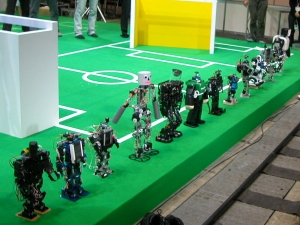 oboCup 2003 in Padua, Italy, and RoboCup 2004 in Lisbon, Portugal, soccer matches were introduced as main KidSize (<60 cm) tournament in 2005. The larger TeenSize robots (initially >65 cm, later the minimal size was increased to 100 cm) continued to play penalty kick, which was developed in 2007 to the Dribble and Kick competition. Dribble and Kick is played between two robots – a striker and the goal keeper. The striker robot starts in the center of the field and the ball is placed randomly on the striker’s goal box. The task of the striker is to move back to approach the ball, dribble the ball across the center line and then kick the ball into the opposing goal. In order to remove subjective judgment from the competition as much as possible, quantitative measures (e.g., goals scored) were seen as much more desirable by the teams. Therefore, the free demonstration event was removed from the competition.
oboCup 2003 in Padua, Italy, and RoboCup 2004 in Lisbon, Portugal, soccer matches were introduced as main KidSize (<60 cm) tournament in 2005. The larger TeenSize robots (initially >65 cm, later the minimal size was increased to 100 cm) continued to play penalty kick, which was developed in 2007 to the Dribble and Kick competition. Dribble and Kick is played between two robots – a striker and the goal keeper. The striker robot starts in the center of the field and the ball is placed randomly on the striker’s goal box. The task of the striker is to move back to approach the ball, dribble the ball across the center line and then kick the ball into the opposing goal. In order to remove subjective judgment from the competition as much as possible, quantitative measures (e.g., goals scored) were seen as much more desirable by the teams. Therefore, the free demonstration event was removed from the competition.
During this time, many formal and informal discussions were held among the technical committee and the participants. After several years, it became apparent that most participants felt that humanoid robots should be limited to human-like kinematics and human-like sensors. As a result of these discussions, the use of omni-vision was disallowed. Furthermore, active sensors (e.g., LIDAR, ultrasound, IR distance sensors) were also forbidden. This was not a major restriction, since from the beginning, color cameras were the most dominant sensor for perceiving the environment. During these years, the performance of the larger robots also improved significantly. Partially driven by the availability of affordable high powered servos, the performance of the smaller TeenSize robots (80 cm to 120 cm and less than 10 kg) had improved to the point where 2 vs. 2 soccer matches became possible. There was a strong push from those teams to introduce soccer games for larger robots. But the largest (>120 cm) and heaviest robots were still too fragile to survive a fall. Furthermore, since some of the robots weighed more than 40 kg, they posed a real danger to other robots or participantsshould they fall. As a consequence, the larger robots were split again into two size classes: The smaller TeenSize robots (100-120 cm) started to play 2 vs. 2 soccer games in 2010, while the AdultSize robots (>130 cm) continued with Dribble and Kick competitions. The rapid improvements in the robots’ capabilities also led to an increase in the complexity and diversity of the technical challenges. The technical challenges introduced during this time includes: walking over uneven terrain, dribbling the ball around multiple poles, dribbling the ball trough randomly placed obstacles, and double passing.
From Individual Skills to Team Play (2008-2012)
In 2008, the number of players in the KidSize soccer matches was increased from 2 to 3 players per team. Furthermore, most teams had successfully solved the problem of locomotion and were able to walk stably over at even surfaces such as hardwood floors or carpets. For these two reasons, the localization (where is the robot?) and the perception of the game situation (where are the ball and the other players?) became more and more important. Whereas individual robot skills (fast walking and strong kicking) were key to success in previous years, now team play and coordination became more important. This was reflected in the rules, e.g. by placement disadvantages for robots which could not autonomously walk to their kicko_ positions. Two teams were powerhouses during that period and won the competition several times. The next wave of major rule changes aimed at making visual perception and localization more realistic. Additional landmarks in the corners of the field and later on the side lines were removed. In 2010, extra lighting on the field was removed, which resulted in much larger variability in brightness due to the influences of environmental lighting. The size of the playing field was extended, and detection of the goals as made more difficult: First the colored goal back walls were removed, leaving only the goal posts as landmarks, and in 2013 both goals were colored yellow. The technical challenges now included throw-ins and high kicks. In the soccer matches, throw-ins are replaced by the referee putting the ball back into play without stopping the match, since a throw-in is an often occurring event that is a time consuming task for a humanoid robot. The throw-in challenge encouraged teams to use throw-ins by the goalie in actual games. The high-kick challenge also encourages the use of the third dimension in the games.
The DARwIn, NimbRo-OP and THOR-OP Platforms (2012–2014)
In 2011, the Korean company Robotis introduced the DARwIn-OP robot, which they had developed in conjunction with Dennis Hong from Virginia Tech. In 2014, 50% of the KidSize teams that submitted qualification material used the DARwIn-OP platform or based their robot on it. Major rule changes at the beginning of this period were to color both goals yellow. A year later, a similar collaboration between Robotis and Bonn University resulted in the development of NimbRo-OP, a teen sized humanoid robot, which is now further developed together with igus GmbH. In 2014, Robotis, Co. Ltd again developed the THOR-OP (Tactical Hazardous Operations Robot – Open Platform) humanoid robot as a general purpose disaster response robot to compete in the DARPA Robotics Challenge (DRC). In order to score in the various DRC tasks, the robot should be able to operate in unstructured environments that include rough terrain, ladders, doorways, piles of debris, and industrial valves. By doing some modifications on the THOR-OP, the University of Pennsylvania RoboCup Team was able to take part in RoboCup 2014 in Brazil where they finished first in AdultSize league. The introduction of these platforms had a big impact on the Humanoid League. Instead of designing and building their robots from scratch, teams could now simply purchase a robot platform that was able to walk and kick a ball and recover from a fall out of the box. So it made qualification and entry into the league much easier for new teams.
However tempting use of off the shelf robots was, teams still worked on individual hardware solutions. A series elastic actuator add-on to widely used Dynamixel servos to absorb shocks, store energy and possibly, with additional displacement sensor allow for dynamic gait in the future was presented by a joint team from Universidade Federal do Santa Maria in Brazil and Ostfalia University from Germany. Another novelty was evaporation cooling of drives introduced by team Sweaty from the University of Applied Sciences in Offenburg. At the end of the 2013 RoboCup competition, the RoboCup Board of Trustees issued a challenge to all leagues as they felt that progress in the leagues had been limited to incremental improvements rather than consequently aiming for the 2050 goal. In response, the 2014 Humanoid league competitions introduced radical changes in the sizes of the Kid, Teen, and AdultSize classes. The maximum height of the robots in the KidSize was raised by 50% to 90 cm. Furthermore, the height limits of the Kid- and TeenSize and the Teen- and AdultSize classes were chosen with an overlap on the upper and lower size limits. This allows easier transition towards larger robots. Furthermore, the field area for KidSize was increased by 125% to 6-9m, and the size of the goals, and the size and weight of the ball were adjusted to accommodate the larger robots. The number of KidSize players was increased to four robots per team. The complexities of the challenges also increased. In the AdultSize dribble and kick competition two obstacles, representing opposing players have been introduced that must be avoided by the striker robot.
An ongoing concern for RoboCup in general and the RoboCup humanoid league in particular is the fact that as the robots become increasingly more complex, it becomes more and more difficult for teams to be able to afford to participate in the RoboCup competition. This problem becomes more pressing by the fact that a full team of soccer players requires eleven players and therefore, the number of players is increased every couple of years. Members of the RoboCup community including the members of the TC of the Humanoid League and the trustees are well aware of this problem and there have been many attempts at fostering joint teams. For example, Team Fumanoids received a RoboCup Federation Grant in 2012 and developed a nice common communication platform for humanoid robots. In 2014, Team Snobots from University of Manitoba in Winnipeg, Canada and Team AUTMan, from Amirkabir University of Technology in Tehran, Iran made the AUT-UofM TeenSize team and generate the first prototype of a TeenSize humanoid robot for competing at RoboCup 2014 in Joe Pessoa, Brasil and won 1st place in the Technical Challenge together with Team Nimbro from University of Bonn, Germany. However, only a few joint teams have taken part in the RoboCup humanoid league so far. This is partly due to the fact that single teams tend to perform better. Another problem is that at the moment forming a joint team results in additional costs for both partners, because of the necessary communication and travel.
Humanoid League Technical Committee

